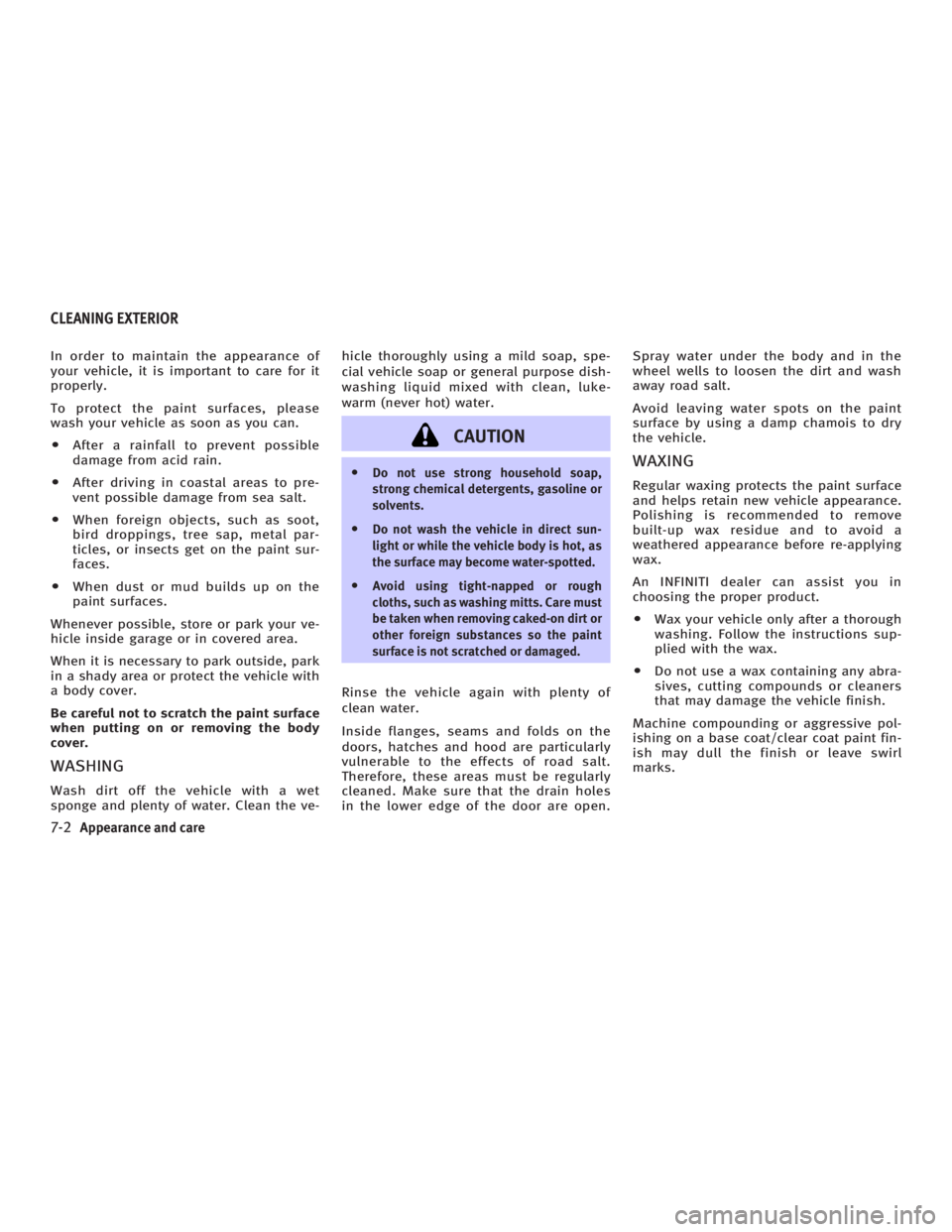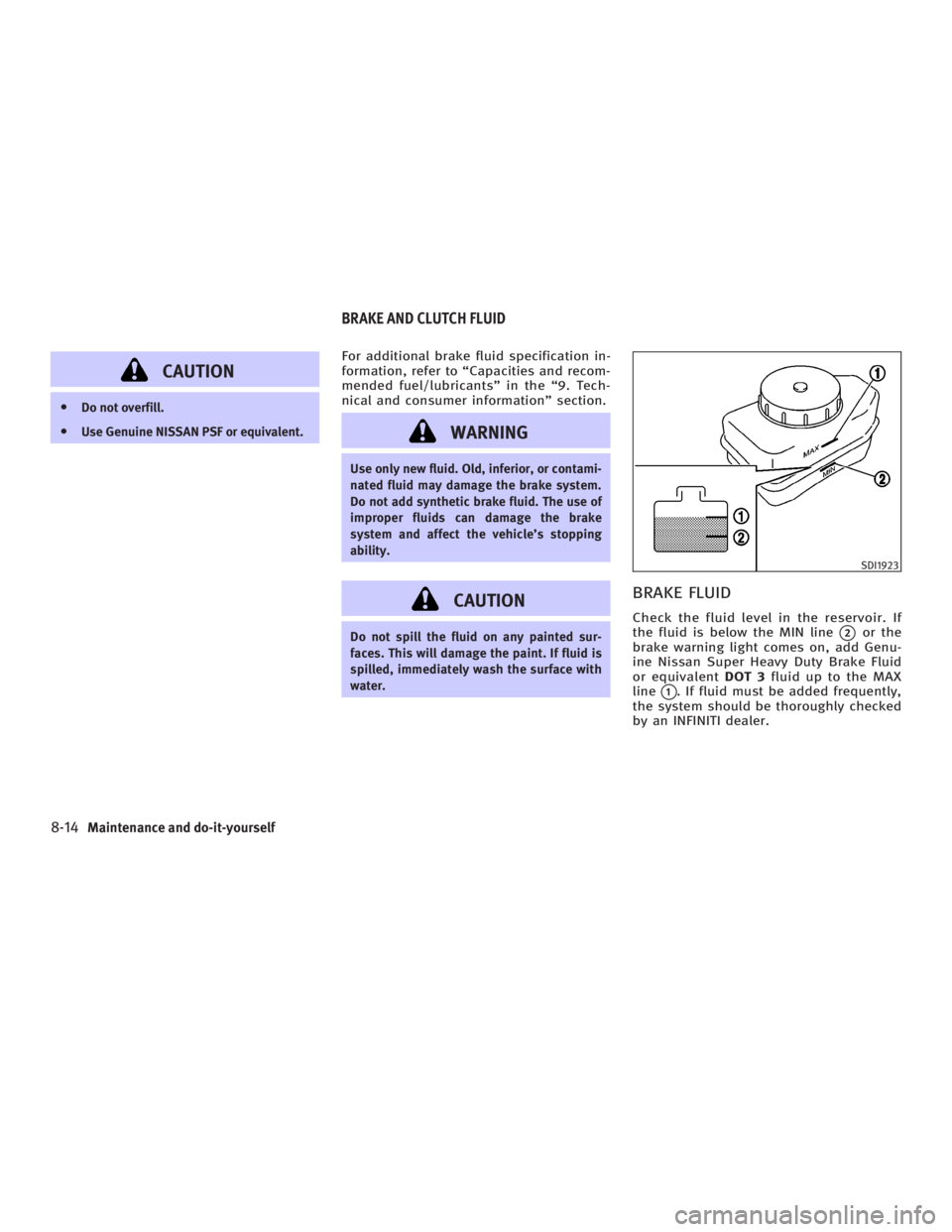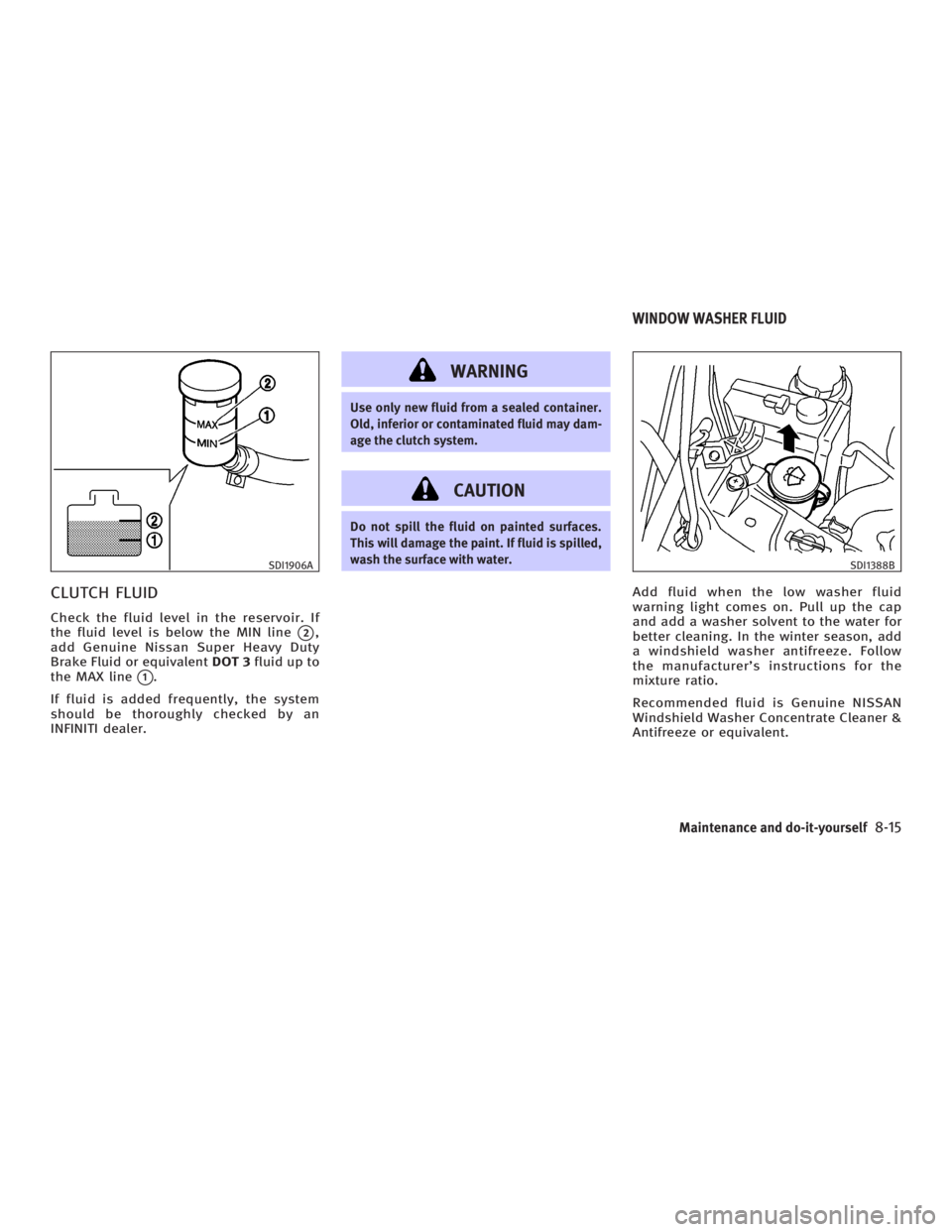2006 INFINITI G35 light
[x] Cancel search: lightPage 254 of 344

In order to maintain the appearance of
your vehicle, it is important to care for it
properly.
To protect the paint surfaces, please
wash your vehicle as soon as you can.
O After a rainfall to prevent possible
damage from acid rain.
O After driving in coastal areas to pre-
vent possible damage from sea salt.
O When foreign objects, such as soot,
bird droppings, tree sap, metal par-
ticles, or insects get on the paint sur-
faces.
O When dust or mud builds up on the
paint surfaces.
Whenever possible, store or park your ve-
hicle inside garage or in covered area.
When it is necessary to park outside, park
in a shady area or protect the vehicle with
a body cover.
Be careful not to scratch the paint surface
when putting on or removing the body
cover.
WASHING Wash dirt off the vehicle with a wet
sponge and plenty of water. Clean the ve- hicle thoroughly using a mild soap, spe-
cial vehicle soap or general purpose dish-
washing liquid mixed with clean, luke-
warm (never hot) water.
CAUTION O Do not use strong household soap,
strong chemical detergents, gasoline or
solvents.
O Do not wash the vehicle in direct sun-
light or while the vehicle body is hot, as
the surface may become water-spotted.
O Avoid using tight-napped or rough
cloths, such as washing mitts. Care must
be taken when removing caked-on dirt or
other foreign substances so the paint
surface is not scratched or damaged.
Rinse the vehicle again with plenty of
clean water.
Inside flanges, seams and folds on the
doors, hatches and hood are particularly
vulnerable to the effects of road salt.
Therefore, these areas must be regularly
cleaned. Make sure that the drain holes
in the lower edge of the door are open. Spray water under the body and in the
wheel wells to loosen the dirt and wash
away road salt.
Avoid leaving water spots on the paint
surface by using a damp chamois to dry
the vehicle.
WAXING Regular waxing protects the paint surface
and helps retain new vehicle appearance.
Polishing is recommended to remove
built-up wax residue and to avoid a
weathered appearance before re-applying
wax.
An INFINITI dealer can assist you in
choosing the proper product.
O Wax your vehicle only after a thorough
washing. Follow the instructions sup-
plied with the wax.
O Do not use a wax containing any abra-
sives, cutting compounds or cleaners
that may damage the vehicle finish.
Machine compounding or aggressive pol-
ishing on a base coat/clear coat paint fin-
ish may dull the finish or leave swirl
marks.CLEANING EXTERIOR
7-2 Appearance and care
w 06.1.4/V35-D/V5.0
X
Page 255 of 344

REMOVING SPOTS Remove tar and oil spots, industrial dust,
insects, and tree sap as quickly as pos-
sible from the surface of the paint to
avoid lasting damage or staining. Special
cleaning products are available at an
INFINITI dealer or any automotive acces-
sory store.
UNDERBODY In areas where road salt is used in winter,
the underbody must be cleaned regularly.
This will prevent dirt and salt from
building up and causing underbody and
suspension corrosion. Before the winter
period and again in the spring, the under-
seal must be checked and, if necessary,
re-treated.
GLASS Use glass cleaner to remove smoke and
dust film from the glass surfaces. It is
normal for glass to become coated with a
film after the vehicle is parked in the hot
sun. Glass cleaner and a soft cloth will
easily remove this film. CAUTION When cleaning the inside of the windows, do
not use sharp-edged tools, abrasive
cleaners or chlorine-based disinfectant
cleaners. They could damage the electrical
conductors, radio antenna elements or rear
window defroster elements.
ALUMINUM ALLOY WHEELS Wash regularly, especially during winter
months in areas where road salt is used.
Salt could discolor the wheel if not re-
moved.
CHROME PARTS Clean all chrome parts regularly with a
non-abrasive chrome polish to maintain
the finish.
TIRE DRESSING INFINITI does not recommend the use of
tire dressings. Tire manufacturers apply a
coating to the tires to help reduce discol-
oration of the rubber. If a tire dressing is
applied to the tires, it may react with the
coating and form a compound. This com- pound may come off the tire while driving
and stain the vehicle paint.
If you choose to use a tire dressing, take
the following precautions:
O Use a water-based tire dressing. The
coating on the tire dissolves more
easily with an oil-based tire dressing.
O Apply a light coat of tire dressing to
help prevent it from entering the tire
tread/grooves (where it would be diffi-
cult to remove).
O Wipe off excess tire dressing using a
dry towel. Make sure the tire dressing
is completely removed from the tire
tread/grooves.
O Allow the tire dressing to dry as rec-
ommended by tire dressing manufac-
turer.
Appearance and care
7-3
w 06.1.4/V35-D/V5.0
X
Page 259 of 344

8 Maintenance and do-it-yourself Maintenance requirements ............................... 8-2
General maintenance........................................ 8-2
Explanation of general maintenance
items .......................................................... 8-3
Maintenance precautions .................................. 8-5
Engine compartment check locations................ 8-7
Engine cooling system ..................................... 8-8
Checking engine coolant level..................... 8-8
Changing engine coolant............................. 8-9
Engine oil ....................................................... 8-10
Checking engine oil level........................... 8-10
Changing engine oil and filter ................... 8-11
Automatic transmission fluid........................... 8-13
Power steering fluid ........................................ 8-13
Brake and clutch fluid..................................... 8-14
Brake fluid................................................. 8-14
Clutch fluid ............................................... 8-15
Window washer fluid ....................................... 8-15
Battery ............................................................ 8-16
Jump starting ............................................. 8-18
Drive belts ...................................................... 8-19
Spark plugs .................................................... 8-19
Replacing spark plugs ............................... 8-20 Air cleaner...................................................... 8-20
Windshield wiper blades ................................. 8-21
Cleaning .................................................... 8-21
Replacing .................................................. 8-22
Parking brake and brake pedal....................... 8-23
Checking parking brake............................. 8-23
Checking brake pedal................................ 8-23
Brake booster ........................................... 8-24
Fuses .............................................................. 8-25
Engine compartment.................................. 8-25
Passenger compartment ............................ 8-27
Keyfob battery replacement ............................ 8-28
Keyfob (except Intelligent Key) .................. 8-28
Intelligent Key ........................................... 8-29
Lights.............................................................. 8-31
Headlights................................................. 8-33
Exterior and interior lights......................... 8-33
Wheels and tires ............................................ 8-37
Tire pressure ............................................. 8-37
Tire labeling .............................................. 8-41
Types of tires ............................................ 8-43
Tire chains ................................................ 8-44
Changing wheels and tires ........................ 8-45
w 06.1.4/V35-D/V5.0
X
Page 261 of 344

EXPLANATION OF GENERAL
MAINTENANCE ITEMS Additional information on the following
items with ª*º is found later in this sec-
tion.
Outside the vehicle The maintenance items listed here should
be performed from time to time, unless
otherwise specified.
Doors and engine hood: Check that all
doors and the engine hood operate prop-
erly. Also ensure that all latches lock se-
curely. Lubricate hinges and latches if
necessary. Make sure that the secondary
latch keeps the hood from opening when
the primary latch is released.
When driving in areas using road salt or
other corrosive materials, check lubrica-
tion frequently.
Lights*: Clean the headlights on a regular
basis. Make sure that the headlights,
stop lights, tail lights, turn signal lights,
and other lights are all operating properly
and installed securely. Also check head-
light aim.
Road wheel nuts (lug nuts): When
checking the tires, make sure no wheel nuts are missing, and check for any loose
wheel nuts. Tighten if necessary.
Tires*: Check the pressure with a gauge
often and always prior to long distance
trips. If necessary, adjust the pressure in
all tires, including the spare, to the speci-
fied pressure. Check carefully for damage,
cuts or excessive wear.
Tire rotation*:
Sedan: The tires should be rotated every
7,500 miles (12,000 km) to minimize tire
wear variation.
Coupe: The tires cannot be rotated.
Tire, wheel alignment and balance: If the
vehicle should pull to either side while
driving on a straight and level road, or if
you detect uneven or abnormal tire wear,
there may be a need for wheel alignment.
If the steering wheel or seat vibrates at
normal highway speeds, wheel balancing
may be needed.
O For additional information regarding
tires, refer to ªImportant Tire Safety
Informationº (US) or ªTire Safety Infor-
mationº (Canada) in the Warranty In-
formation Booklet. Windshield: Clean the windshield on a
regular basis. Check the windshield at
least every six months for cracks or other
damage. Have a damaged windshield re-
paired by a qualified repair facility.
Windshield wiper blades*: Check for
cracks or wear if they do not wipe prop-
erly.
Maintenance and do-it-yourself
8-3
w 06.1.4/V35-D/V5.0
X
Page 262 of 344

Inside the vehicle The maintenance items listed here should
be checked on a regular basis, such as
when performing periodic maintenance,
cleaning the vehicle, etc.
Accelerator pedal: Check the pedal for
smooth operation and make sure the
pedal does not catch or require uneven
effort. Keep the floor mat away from the
pedal.
Automatic transmission P (Park) mecha-
nism: On a fairly steep hill check that your
vehicle is held securely with the selector
lever in the P (Park) position without ap-
plying any brakes.
Brake pedal*: Check the pedal for smooth
operation and make sure it has the proper
distance under it when depressed fully.
Check the brake booster function. Be sure
to keep the floor mat away from the
pedal.
Brakes: Check that the brakes do not pull
the vehicle to one side when applied.
Parking brake*: Check that the pedal/
lever has the proper travel and confirm
that your vehicle is held securely on a
fairly steep hill with only the parking
brake applied. Seats: Check seat position controls such
as seat adjusters, seatback recliner, etc.
to ensure they operate smoothly and that
all latches lock securely in every position.
Check that the head restraints move up
and down smoothly and that the locks (if
so equipped) hold securely in all latched
positions.
Seat belts: Check that all parts of the seat
belt system (For example, buckles, an-
chors, adjusters and retractors) operate
properly and smoothly, and are installed
securely. Check the belt webbing for cuts,
fraying, wear or damage.
Steering wheel: Check for changes in the
steering conditions, such as excessive
free play, hard steering or strange noises.
Warning lights and chimes: Make sure
that all warning lights and chimes are op-
erating properly.
Windshield defroster: Check that the air
comes out of the defroster outlets prop-
erly and in sufficient quantity when oper-
ating the heater or air conditioner.
Windshield wiper and washer*: Check that
the wipers and washer operate properly
and that the wipers do not streak. Under the hood and the vehicle The maintenance items listed here should
be checked periodically (For example,
each time you check the engine oil or re-
fuel).
Battery*: Check the fluid level in each
cell. It should be between the MAX and
MIN lines. Vehicles operated in high tem-
peratures or under severe conditions re-
quire frequent checks of the battery fluid
level.
Brake and clutch fluid level*: Make sure
that the brake and clutch fluid levels are
between the MAX and MIN lines on the
reservoir.
Engine coolant level*: Check the coolant
level when the engine is cold.
Engine drive belts*: Make sure that no
belt is frayed, worn, cracked or oily.
Engine oil level*: Check the level after
parking the vehicle on a level location
and turning off the engine. (Wait at least
10 minutes for the oil to drain back into
the oil pan.)
Exhaust system: Make sure there are no
loose supports, cracks or holes. If the
sound of the exhaust seems unusual or
8-4 Maintenance and do-it-yourself
w 06.1.4/V35-D/V5.0
X
Page 270 of 344

O Waste oil must be disposed of prop-
erly.
O Check your local regulations.
4. Loosen the oil filter with an oil filter
wrench
q B
. Remove the oil filter by
turning it by hand.
5. Wipe the engine oil filter mounting
surface with a clean rag.
Be sure to remove any old rubber
gasket remaining on the mounting sur-
face of the engine.
6. Coat the gasket on the new filter with
clean engine oil.
7. Screw in the oil filter clockwise until a
slight resistance is felt, then tighten
additionally more than 2/3 turn.
Oil filter tightening torque:
11 to 15 ft-lb
(14.7 to 20.5 N z m)
8. Clean and re-install the drain plug
with a new washer. Securely tighten
the drain plug with a wrench.
Drain plug tightening torque:
22 to 29 ft-lb
(29 to 39 N z m)
Do not use excessive force. 9. Refill engine with recommended oil
and install the cap securely.
CAUTION The dipstick must be inserted in place to pre-
vent oil spillage from the dipstick hole while
filling the engine with oil.
See ªCapacities and recommended
fuel/lubricantsº in the ª9. Technical
and consumer informationº section for
drain and refill capacity. The drain and
refill capacity depends on the oil tem-
perature and drain time. Use these
specifications for reference only. Al-
ways use the dipstick to determine the
proper amount of oil in the engine.
CAUTION When filling oil, do not pull out the dipstick.
10. Start the engine and check for
leakage around the drain plug and
the oil filter. Correct as required. 11. Turn the engine off and wait more
than 10 minutes. Check the oil level
with the dipstick. Add engine oil if
necessary.
After the operation 1. Install the engine undercover into po-
sition as the following steps.
a. Pull the center of the small plastic
clip out.
b. Hold the engine undercover into
position.
c. Insert the clip through the under-
cover into the hole in the frame,
then push the center of the clip in
to lock the clip in place.
d. Install the other bolts that hold the
undercover in place. Be careful not
to strip the bolts or over-tighten
them.
2. Lower the vehicle carefully to the
ground.
3. Dispose of waste oil and filter prop-
erly.
8-12 Maintenance and do-it-yourself
w 06.1.4/V35-D/V5.0
X
Page 272 of 344

CAUTIONO Do not overfill.
O Use Genuine NISSAN PSF or equivalent. For additional brake fluid specification in-
formation, refer to ªCapacities and recom-
mended fuel/lubricantsº in the ª9. Tech-
nical and consumer informationº section.
WARNING Use only new fluid. Old, inferior, or contami-
nated fluid may damage the brake system.
Do not add synthetic brake fluid. The use of
improper fluids can damage the brake
system and affect the vehicle's stopping
ability.
CAUTION Do not spill the fluid on any painted sur-
faces. This will damage the paint. If fluid is
spilled, immediately wash the surface with
water.
BRAKE FLUID Check the fluid level in the reservoir. If
the fluid is below the MIN line
q 2
or the
brake warning light comes on, add Genu-
ine Nissan Super Heavy Duty Brake Fluid
or equivalent DOT 3 fluid up to the MAX
line
q 1
. If fluid must be added frequently,
the system should be thoroughly checked
by an INFINITI dealer. SDI1923
BRAKE AND CLUTCH FLUID
8-14 Maintenance and do-it-yourself
w 06.1.4/V35-D/V5.0
X
Page 273 of 344

CLUTCH FLUID Check the fluid level in the reservoir. If
the fluid level is below the MIN line
q 2
,
add Genuine Nissan Super Heavy Duty
Brake Fluid or equivalent DOT 3 fluid up to
the MAX line
q 1
.
If fluid is added frequently, the system
should be thoroughly checked by an
INFINITI dealer. WARNING Use only new fluid from a sealed container.
Old, inferior or contaminated fluid may dam-
age the clutch system.
CAUTION Do not spill the fluid on painted surfaces.
This will damage the paint. If fluid is spilled,
wash the surface with water.
Add fluid when the low washer fluid
warning light comes on. Pull up the cap
and add a washer solvent to the water for
better cleaning. In the winter season, add
a windshield washer antifreeze. Follow
the manufacturer's instructions for the
mixture ratio.
Recommended fluid is Genuine NISSAN
Windshield Washer Concentrate Cleaner &
Antifreeze or equivalent.SDI1906A SDI1388B
WINDOW WASHER FLUID
Maintenance and do-it-yourself
8-15
w 06.1.4/V35-D/V5.0
X